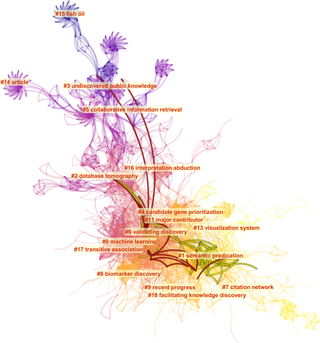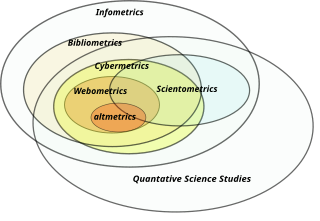Related Research Articles
A citation index is a kind of bibliographic index, an index of citations between publications, allowing the user to easily establish which later documents cite which earlier documents. A form of citation index is first found in 12th-century Hebrew religious literature. Legal citation indexes are found in the 18th century and were made popular by citators such as Shepard's Citations (1873). In 1961, Eugene Garfield's Institute for Scientific Information (ISI) introduced the first citation index for papers published in academic journals, first the Science Citation Index (SCI), and later the Social Sciences Citation Index (SSCI) and the Arts and Humanities Citation Index (AHCI). American Chemical Society converted its printed Chemical Abstract Service into internet-accessible SciFinder in 2008. The first automated citation indexing was done by CiteSeer in 1997 and was patented. Other sources for such data include Google Scholar, Microsoft Academic, Elsevier's Scopus, and the National Institutes of Health's iCite.

Bibliometrics is the application of statistical methods to the study of bibliographic data, especially in scientific and library and information science contexts, and is closely associated with scientometrics to the point that both fields largely overlap.

Derek John de Solla Price was a British physicist, historian of science, and information scientist. He was known for his investigation of the Antikythera mechanism, an ancient Greek planetary computer, and for quantitative studies on scientific publications, which led to his being described as the "Herald of scientometrics".
Scientometrics is a subfield of informetrics that studies quantitative aspects of scholarly literature. Major research issues include the measurement of the impact of research papers and academic journals, the understanding of scientific citations, and the use of such measurements in policy and management contexts. In practice there is a significant overlap between scientometrics and other scientific fields such as information systems, information science, science of science policy, sociology of science, and metascience. Critics have argued that overreliance on scientometrics has created a system of perverse incentives, producing a publish or perish environment that leads to low-quality research.
Citation analysis is the examination of the frequency, patterns, and graphs of citations in documents. It uses the directed graph of citations — links from one document to another document — to reveal properties of the documents. A typical aim would be to identify the most important documents in a collection. A classic example is that of the citations between academic articles and books. For another example, judges of law support their judgements by referring back to judgements made in earlier cases. An additional example is provided by patents which contain prior art, citation of earlier patents relevant to the current claim. The digitization of patent data and increasing computing power have led to a community of practice that uses these citation data to measure innovation attributes, trace knowledge flows, and map innovation networks.

Eugene Eli Garfield was an American linguist and businessman, one of the founders of bibliometrics and scientometrics. He helped to create Current Contents, Science Citation Index (SCI), Journal Citation Reports, and Index Chemicus, among others, and founded the magazine The Scientist.

Informetrics is the study of quantitative aspects of information, it is an extension and evolution of traditional bibliometrics and scientometrics. Informetrics uses bibliometrics and scientometrics methods to study mainly the problems of literature information management and evaluation of science and technology. Informetrics is an independent discipline that uses quantitative methods from mathematics and statistics to study the process, phenomena, and law of informetrics. Informetrics has gained more attention as it is a common scientific method for academic evaluation, research hotspots in discipline, and trend analysis.
Howard D. White is a scientist in library and information science with a focus on informetrics and scientometrics.
Citation impact or citation rate is a measure of how many times an academic journal article or book or author is cited by other articles, books or authors. Citation counts are interpreted as measures of the impact or influence of academic work and have given rise to the field of bibliometrics or scientometrics, specializing in the study of patterns of academic impact through citation analysis. The importance of journals can be measured by the average citation rate, the ratio of number of citations to number articles published within a given time period and in a given index, such as the journal impact factor or the citescore. It is used by academic institutions in decisions about academic tenure, promotion and hiring, and hence also used by authors in deciding which journal to publish in. Citation-like measures are also used in other fields that do ranking, such as Google's PageRank algorithm, software metrics, college and university rankings, and business performance indicators.
The h-index is an author-level metric that measures both the productivity and citation impact of the publications, initially used for an individual scientist or scholar. The h-index correlates with success indicators such as winning the Nobel Prize, being accepted for research fellowships and holding positions at top universities. The index is based on the set of the scientist's most cited papers and the number of citations that they have received in other publications. The index has more recently been applied to the productivity and impact of a scholarly journal as well as a group of scientists, such as a department or university or country. The index was suggested in 2005 by Jorge E. Hirsch, a physicist at UC San Diego, as a tool for determining theoretical physicists' relative quality and is sometimes called the Hirsch index or Hirsch number.
The Science Citation Index Expanded – previously titled Science Citation Index – is a citation index originally produced by the Institute for Scientific Information (ISI) and created by Eugene Garfield.

Louis André (Loet) Leydesdorff (21 August 1948, Batavia was a Dutch sociologist, cyberneticist, communication scientist and Professor in the Dynamics of Scientific Communication and Technological Innovation at the University of Amsterdam. He is known for his work in the sociology of communication and innovation, especially for his Triple helix model of innovation developed with Henry Etzkowitz in the 1990s.
The International Society for Scientometrics and Informetrics was founded in 1993 in Berlin at the International Conference on Bibliometrics, Informetrics and Scientometrics. It is an association for professionals in the field of scientometrics.
Blaise Cronin is an Irish-American information scientist and bibliometrician. He is the Rudy Professor Emeritus of Information Science at Indiana University, Bloomington, where he was Dean of the School of Library and Information Science for seventeen years. From 1985 to 1991 he held the Chair of Information Science and was Head of the Department of Information Science at the University of Strathclyde in Glasgow, U.K.
Author-level metrics are citation metrics that measure the bibliometric impact of individual authors, researchers, academics, and scholars. Many metrics have been developed that take into account varying numbers of factors.
There are a number of approaches to ranking academic publishing groups and publishers. Rankings rely on subjective impressions by the scholarly community, on analyses of prize winners of scientific associations, discipline, a publisher's reputation, and its impact factor.
Judit Bar-Ilan was an Israeli computer scientist known for her research in informetrics and scientometrics. She was a professor of information science, and head of the Department of Information Science at Bar-Ilan University.

Ronald Rousseau is a Belgian mathematician and information scientist. He has obtained an international reputation for his research on indicators and citation analysis in the fields of bibliometrics and scientometrics.
The Derek de Solla Price Memorial Award, or Price Medal, was conceived to honor Derek J. de Solla Price for his contributions to information science and for his crucial role in developing the field of scientometrics. The award was launched by Tibor Braun, founder of the international journal Scientometrics, and is periodically awarded by the journal to scientists with outstanding contributions to the fields of quantitative studies of science. The awarding ceremony is part of the annual ISSI conference. The first medal was awarded to Eugene Garfield in 1984. The full list of winners can be found below.
The Leiden Manifesto for research metrics (LM) is a list of "ten principles to guide research evaluation", published as a comment in Volume 520, Issue 7548 of Nature, on 22 April 2015. It was formulated by public policy professor Diana Hicks, scientometrics professor Paul Wouters, and their colleagues at the 19th International Conference on Science and Technology Indicators, held between 3–5 September 2014 in Leiden, The Netherlands.
References
- ↑ Borgman, Christine L. (October 1989). "Bibliometrics and Scholarly Communication: Editor's Introduction". Communication Research. 16 (5): 583–599. doi:10.1177/009365089016005002.
- ↑ Budd, John M. (1988). "A Bibliometric Analysis of Higher Education Literature". Research in Higher Education. 28 (2): 180–190. ISSN 0361-0365.
- ↑ O'Connor, Daniel (July 2016). "Beyond Bibliometrics: Harnessing Multidimensional Indicators of Scholarly Intent". Journal of the Association for Information Science and Technology. 67 (7): 1780–1783. doi:10.1002/asi.23632.
- ↑ Furner, Jonathan (Spring 2004). "A Brilliant Mind: Margaret Egan and Social Epistemology". Library Trends. 52 (4): 792–809.
- ↑ "Eugene Garfield - an overview". ScienceDirect Topics.
- ↑ Shah, Faaiz Ali; Jawaid, Shaukat Ali (24 January 2023). "The h-Index: An Indicator of Research and Publication Output". Pakistan Journal of Medical Sciences. 39 (2). doi:10.12669/pjms.39.2.7398. PMC 10025721 .
- ↑ Center For Naval Analyses (March 1, 1978). "Bibliometric Studies of Scientific Productivity". Defense Technical Information Center.
- ↑ Hood, William W.; Wilson, Concepción S. (2001). "The Literature of Bibliometrics, Scientometrics, and Informetrics". Scientometrics. 52 (2): 291–314. doi:10.1023/A:1017919924342.
- ↑ Garfield, E. (March 1985). "In tribute to Derek John de Solla Price: a citation analysis of little science, big sicence". Scientometrics. 7 (3–6): 487–503. doi:10.1007/BF02017163.
- ↑ Rousseau, Ronald (June 2014). "Forgotten founder of bibliometrics". Nature. 510 (7504): 218–218. doi:10.1038/510218e.
- ↑ Kanwal, Jasmeen; Smith, Kenny; Culbertson, Jennifer; Kirby, Simon (August 2017). "Zipf's Law of Abbreviation and the Principle of Least Effort: Language users optimise a miniature lexicon for efficient communication". Cognition. 165: 45–52. doi:10.1016/j.cognition.2017.05.001. hdl: 20.500.11820/c0d09559-27af-429b-b624-f5d32c517165 .